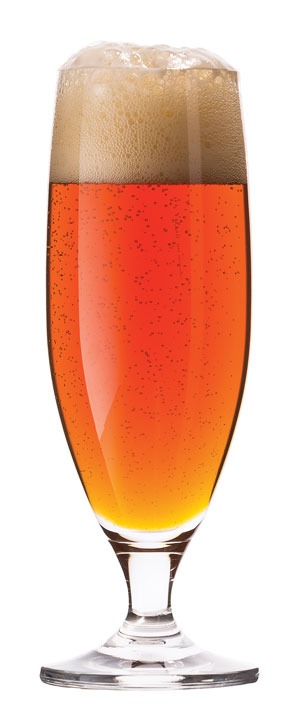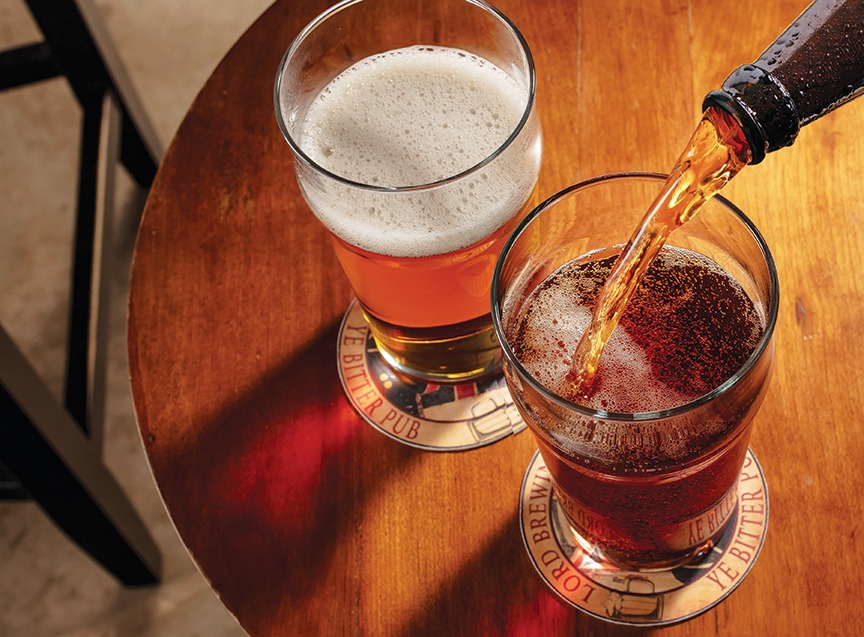Bière de Garde: From the French countryside

Bière de garde, a historical regional beer style from the borderlands of France and Belgium, has undergone a modern update from its farmhouse brewing origins. People are often confused by the characterization of saison along with bière de garde as farmhouse styles, thinking that they must have a similar flavor profile — but that is far from the case. “Farmhouse” relates to the self-sufficient brewing tradition of farmers using their crops to create beer for themselves and their field workers. The term says nothing about the beers themselves, and it certainly shouldn’t be interpreted as implying that a funky barnyard (or Brettanomyces) character exists in the beers.
Much like saison, bière de garde does come in various strengths and colors, although the amber color is most traditional. Its roots as a provision beer (a beer made for storing and later consumption, like stock ales and keeping beers) means that most modern examples are stronger-than-average, above 6% alcohol. Modern examples include blond and brown colors, in addition to the original amber. The biggest difference from saison is the balance – saison is hoppy and bitter with a strong yeast profile, while bière de garde is malty, smooth, and sometimes a little fruity.
Bière de garde is categorized by the Beer Judge Certification Program (BJCP) as Style 24C in the Belgian Ales style category, along with witbier and Belgian pale ale. Despite the category name, the style itself is French — but from the region bordering Belgium.
Bière de Garde History
The northern region of France that borders the Belgian provinces of West Flanders and Hainaut was once part of the historical County of Flanders, and continues to share their agricultural and brewing traditions. The country of France is divided into administrative régions (like U.S. states), then départements (like U.S. counties), then smaller arrondissements, communes, or cantons. The Hauts-de-France région consists of the départements of Pas-de-Calais and Nord, as well as the former départements of Picardie (Aisne, Oise, and Somme). This new political organization took effect in 2016, so many older references will use other names. Lille is the prefecture (administrative capital) of Hauts-de-France, and is also the center of bière de garde popularity.
While best known for its wine, France is actually a major cereal grain producer (the largest in the European Union). Most of its malted barley is exported, however. The area of France where bière de garde originates is near rich agricultural ground and is not involved in wine production (the nearest wine region is Champagne to the east and south). The hop industry is also in the area with Belgium’s Poperinge just over the border. Poperinge produces 80% of Belgium’s hops while those of France tend to come from Alsace, further to the east.
Much like saison, bière de garde does come in various strengths and colors, although the amber color is most traditional.
France, like Belgium, has a farmhouse brewing tradition. However, older beer for use on the farm was likely much lower alcohol than today’s versions. Alcohol and farm equipment don’t mix, regardless of the era. Older references from 1900 and earlier refer to a bière de garde of Lille being aged and vinous, meaning it had a sour profile. Remember this region is very close to Flanders, which had similar beers. But the name bière de garde does not have a continuous link to these types of beers.
The word garde comes from the French verb garder, meaning to keep, maintain, guard, or store. Farmhouse beers were produced in season for current consumption, and also brewed stronger to store during warmer months when brewing was not practical. While the farmhouse story is part of the heritage, the name has become more associated with an increasingly strong modern product, almost like doppelbock in strength.
Modern bière de garde traces its roots to Jenlain Ambrée (Amber), first brewed at Brasserie Duyck in 1922 in the town of Jenlain. Originally a draft product of perhaps 3–4% alcohol, it was first bottled in the 1940s. Later in the 1950s it was reformulated as a higher alcohol product (6.5%) and packaged in a corked Champagne-like bottle. It became popular among university students in the 1970s, which inspired many other regional French breweries to produce a similar beer. In effect, it became a modern style at this time when it began to be produced under this name, and associated with this region. Jenlain was reformulated again in the 2000s and is now a 7.5% product.
This notion of becoming a style is reinforced by reading Michael Jackson’s contemporary accounts of the beer. In his 1977 World Guide to Beer, he simply mentions Jenlain as a French beer. But in his 1988 New World Guide to Beer, he devotes an entire section to the bière de garde style and names several commercial examples. So, despite a fanciful history, the modern style we know really took form in the 1970s and 1980s as breweries such as La Choulette, Theillier, Castelain, St. Sylvestre, and others sought to emulate the success of Jenlain and to leverage the established style name.
Phil Markowski in Farmhouse Ales suggests a link to bière de mars, a spring seasonal ale from Alsace. Surely, modern bière de garde has a similar profile. He also suggests that before World War I, the French had a taste for darker, maltier beers like bock. He also points to altbier production methods. I’m not sure I see a connection, but there are similarities. Correlation without causation, perhaps?
Sensory Profile
Since bière de garde has three color variants (blond, amber, and brown), the sensory profile can change while retaining a similar general balance. The color differences are self-explanatory, and clarity and head formation are usually pretty good. Alcohol is 6 to 8.5%, although most modern examples are above 7%.
The balance of all are malty-but-dry. The body is often described as “lean” but this should be thought of as having a medium to medium-light body with a dry, smooth finish. Maltiness tends to dominate, but it should not have a heavy sweetness. The malt is forward because of restrained bitterness and light hopping, not because of residual sweetness. As with other styles that have a range of colors (like bocks), the paler versions tend to be a little hoppier.
The malt character is often toasty and a little caramelly, maybe with some biscuity accents. Darker versions can be maltier, but should not dive into roasty flavors. Paler versions have reduced caramel flavors. Light fruity esters can accentuate the malt, and some spicy, peppery, or herbal hop flavor can add interest at a light level. Stronger versions can have a light alcohol quality. The fermentation character is very clean, often with just a light fruitiness.
In the past, this style was often described as having a musty or cellar-like quality — as if mere storage in a basement would somehow impart basement-like flavors to a beer. This character in commercial beer comes from the use of natural cork, which can give that harsh, dry, moldy character in old examples. My late friend Tom Fitzpatrick helped me understand this distinction through his detailed tasting notes of fresh bière de garde while in France in 2009. One more example where defining styles based solely on tasting notes of old imports is dangerous — local research is a must for accurate sensory descriptions.
Brewing Ingredients and Methods
Bière de garde is kind of a hybrid style in that it traditionally is top-fermented like an ale and then lagered — similar to altbier and Kölsch. However, some larger modern producers use warm-fermented lager yeast (like California common). Both are reasonable, as they give the clean profile, smooth finish, and perhaps light esters. A four- to six-week lagering period near freezing temperatures, as with alt and Kölsch, is appropriate.
Maltiness tends to dominate, but it should not have a heavy sweetness.
The lighter body and dry finish are normally produced through a step-infusion mash (again, like altbier). Some producers add up to 10% sugar to encourage a dry finish. In Farmhouse Ales, Markowski points out that larger producers are more likely to use a simple grain bill while smaller, artisanal producers often will go with more complexity. Jenlain says it uses three malts and three hops, supposedly Pilsner, Munich, and crystal and Magnum, Brewer’s Gold, and Strisselspalt, respectively.
Maltsters in the area are Malteries Franco-Belge (MFB) and Castle Maltings (just over the border in Belgium). Malts from these maltsters would be most authentic; selecting something from Belgium or Germany would be my next choice. A grist with a base of Pilsner or pale ale malt, with Munich and/or Vienna, some mix of crystal malts appropriate for the color beer, and perhaps a touch (less than 1%) of something dark to adjust color but not add flavor; is a good starting point. Avoid anything too grainy or roasty.
Hopping is normally done with bittering and late additions but the late hops are normally fairly light in quantity. Bitterness is kept restrained (18–25 IBUs) so as to give the beer a malty overall impression. While French brewing water is normally fairly hard, brewers take pains to remove carbonates. So soft water with low carbonates and sulfates is typical. This water profile emphasizes the malty flavors in beer.
I have not been able to identify a Jenlain-type yeast strain. White Labs makes two yeasts well suited to this style, WLP072 (French Ale) and WLP073 (Artisanal Country Ale). Wyeast 3725-PC (Bière de Garde) is also a strong choice when available. More available strains would be something with European ale or German ale in the name. I’ve seen some Belgian strains suggested but I’d be careful about using anything too phenolic. Clean German lager yeast strains are an alternative, if you want to go the lager route with a fermentation temperature around 59 °F (15 °C).
I have seen some people recommending adding corks to the boil or other nonsense to add a “cellar” character to the beer. Please don’t. This is not a traditional part of the style and perpetuates the false myth that faults are acceptable.
Homebrew Example
I’m going classic here, an amber bière de garde in the style of Jenlain using (mostly) malts from the area. MFB malt is preferred, with Castle a close second. To amp up the toasty qualities, I’ll use Vienna malt in addition to Pils, and use dark Munich malt for more malt flavor (this malt is a little non-traditional, admittedly). A little crystal-type malt for flavor with just a dash of dark malt for color adjustment rounds out the grain bill. I’m keeping the alcohol level to around 7%, as I think the 8.5% versions are a little harder to drink. A step mash is used for attenuation. I’m avoiding sugars as I’d like to keep the malt flavor up, and the alcohol level in check.
French hops are classic, although they can be a little hard to find. English Fuggle can be a substitute for bittering hops and German/Czech noble hops can be used for finishing. I’ll use one of the specialty yeast strains noted for making bière de garde and I’ll definitely lager this beer. My standard water treatment works well for this malty style. I’ve made this beer using a warm-fermented lager yeast and it also works. A strain like Wyeast 2206 (Bavarian Lager) or 2124 (Bohemian Lager) is appropriate (W34/70 dry yeast is fine).
Many beer styles have been reinvented over the years, retaining historical names and traditions while not having a continuous brewing history. I don’t really have a problem with that, as tastes change over time and brewers use new production methods and ingredients. The only problem arises when people don’t understand this evolution and assume that modern beers are true historic recreations. So, to quote Marty McFly, “watch for the changes and try to keep up.”
Bière de Garde by the Numbers
OG: 1.060–1.080
FG: 1.008–1.016
SRM: 9–19
IBU: 18–28
ABV: 6–8.5%
Bière de Garde
(5 gallons/19 L, all-grain)
OG = 1.067 FG = 1.015
IBU = 20 SRM = 14 ABV = 7.1%
Ingredients
5 lbs. (2.3 kg) Malteries Franco-Belge (MFB) Pilsner malt
6 lbs. (2.7 kg) MFB Vienna malt
1.5 lbs. (680 g) dark Munich (Munich II) malt
0.75 lb. (340 g) MFB Caramel Vienna malt (20 °L)
0.75 lb. (340 g) MFB Caramel Munich 60 malt (60 °L)
1 oz. (28 g) Carafa® III Special malt (or other debittered black malt)
6 AAU Brewer’s Gold hops (60 min.) (1 oz./28 g at 6% alpha acids)
2 AAU Strisselspalt hops (15 min.) (0.5 oz. /14 g at 4% alpha acids)
White Labs WLP072 (French Ale), Wyeast 3725-PC (Bière de Garde), or SafLager W-34/70 yeast
3⁄4 cup corn sugar (for priming)
Step by Step
This recipe uses reverse osmosis (RO) water. Adjust all brewing water to a pH of 5.5 using phosphoric acid. Add 1 tsp. of CaCl2 to the mash.
This recipe uses a step infusion mash. Use enough water to have a moderately thick mash (1.5 qts./lb. or 3.1 L/kg). Mash in the Pilsner, Vienna, and dark Munich malts at 131 °F (55 °C) and hold for 15 minutes for a protein rest. Raise temperature through infusion or direct heat to 144 °F (62 °C) then hold for a beta amylase rest for 30 minutes. Raise temperature to 158 °F (70 °C) for an alpha amylase rest and hold for 15 minutes. Add the crystal and dark malts. Begin recirculating, raise the mash temperature to 169 °F (76 °C) for a mash out and recirculate for 15 minutes.
Sparge slowly and collect 6.5 gallons (24.5 L) of wort in the boil kettle. Boil the wort for 90 minutes, adding hops at the times indicated.
Chill the wort to 68 °F (20 °C), pitch the yeast, and ferment until complete. Rack the beer off the yeast or dump the yeast, then lager at 32 °F (0 °C) for 4–6 weeks. Rack the beer, prime and bottle condition, or keg and force carbonate the beer to 2.5 volumes.
Bière de Garde
(5 gallons/19 L, extract with grains)
OG = 1.067 FG = 1.015
IBU = 20 SRM = 14 ABV = 7.1%
Ingredients
8.4 lbs. (3.8 kg) light liquid malt extract
0.75 lb. (340 g) MFB Caramel Vienna malt (20 °L)
0.75 lb. (340 g) MFB Caramel Munich 60 malt (60 °L)
1 oz. (28 g) Carafa® III Special malt (or other debittered black malt)
6 AAU Brewer’s Gold hops (60 min.) (1 oz./28 g at 6% alpha acids)
2 AAU Strisselspalt hops (15 min.) (0.5 oz. /14 g at 4% alpha acids)
White Labs WLP072 (French Ale), Wyeast 3725-PC (Bière de Garde), or SafLager W-34/70 yeast
3⁄4 cup corn sugar (for priming)
Step by Step
Use 6.5 gallons (24.5 L) of water in the brew kettle; heat to 158 °F (70 °C). Turn off the heat. Add the three crushed malts in a mesh bag and steep for 30 minutes. Remove and rinse grains gently.
Add the malt extract and stir thoroughly to dissolve completely. Once fully dissolved, turn the heat back on and bring to a boil. Boil the wort for 60 minutes, adding hops at the times indicated.
Chill the wort to 68 °F (20 °C), pitch the yeast, and ferment until complete. Rack the beer off the yeast or dump the yeast, then lager at 32 °F (0 °C) for 4–6 weeks. Rack the beer, prime and bottle condition, or keg and force carbonate the beer to 2.5 volumes.



